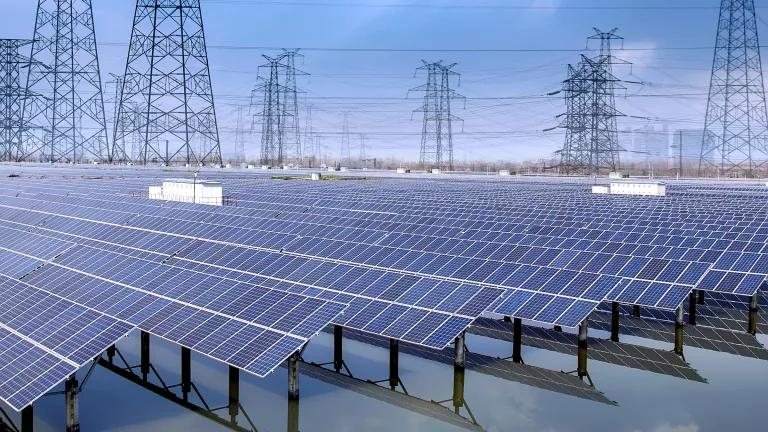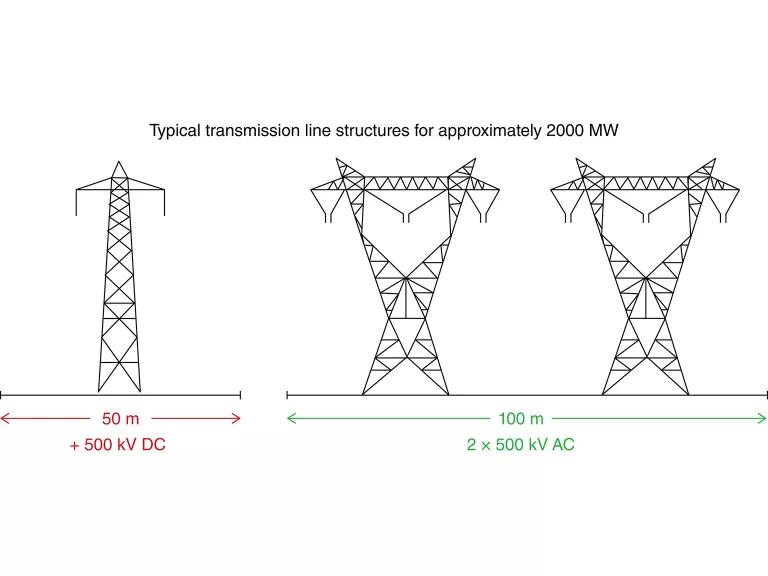MISO’s Clean Energy Dreams Hinge on a State-of-the-Art Grid
As the Midwest’s grid operator plans new transmission lines for a clean energy future, it must not miss the window for investing in a technologically advanced grid.

A solar panel array below large transmission towers with overhead power lines
Jeff Hu/iStock
As MISO (Midcontinent Independent System Operator) plans new transmission lines for a future that will include a surge of renewable energy, it is critical for the grid operator of the U.S. Midwest not to miss its window for investing in a state-of-the-art grid.
When it comes to expanding and updating the power grid, planners can balk at the big investments needed for big improvements. But we cannot afford to aim low and just keep building more of the same lower-voltage transmission lines that currently crisscross MISO’s footprint. Instead, we need larger, 765-kilovolt (kV) and HVDC (high-voltage direct current) transmission lines, which bring a host of benefits that are needed to support our transition to a clean energy future, including the ability to convey large volumes of electricity over long distances to tap into different weather systems as weather becomes our fuel.
Failing to invest in higher-voltage line technology now may prove to be a massive hindrance later to mass renewables that can cut costs and increase reliability. That’s a concern for MISO and other grid planners looking ahead to a future where renewable power accounts for an increasing share of new energy. MISO is planning for a system with 80 percent annual renewable penetration within 20 years. The magnitude of the change in our electricity generation requires the support of a higher-voltage, higher-capacity superhighway/backbone of either 765 kV and/or HVDC.
The reason is that renewable power from the sun and wind increases the variability of grid operations and the need for reserve power, factors that require a grid with more flexible power flow control. While both 765-kV and HVDC technologies will have a role in the grid of the future, we focus on the benefits of voltage source converter (VSC)-HVDC lines in this article. VSC-HVDC lines increase capabilities for power-flow control, inherent reactive power, and voltage support, dynamic stability, and synthetic inertia, which then help to integrate renewable power by providing more controllability and stability to support a grid with more variable generation.
In addition, VSC-HVDC lines lose less power than HVAC (high-voltage alternating current) lines, making them more efficient over long distances. And as we reach higher penetrations of wind and solar, resources that rely on the weather for their fuel, it will be important to be able to convey renewable electricity across long distances to tap into different weather systems. In a future where cheap renewable power must be delivered over long stretches to cities and towns, more efficient transmission will save consumers money. VSC-HVDC lines, when integrated with existing AC lines, provide independent control of active and reactive power, the two types of power needed operate our electrical grid, as well as fast frequency response and black start capability, which improve the ability of the grid to avoid blackouts or to restart parts of the power system to recover from a blackout.
And, since VSC-HVDC lines are bigger, you need fewer of them to carry the same amount of power to consumers. That means fewer battles with opponents, fewer permits, and a smaller amount of land needed. Why build two divided two-lane highways when you can get the job done with a single-lane expressway?

Hasanuzzaman, Md & Zubir, Ummu & Ilham, nur iqtiyani & Che, Hangseng. (2016). Global electricity demand, generation, grid system, and renewable energy polices: a review
A year ago, MISO approved the largest investment in transmission lines ever in the United States, a long-overdue step forward for an electricity system anticipating major growth. The move clears the path for an estimated 53 gigawatts of new wind and solar energy, other renewables, plus storage and battery projects—enough to power 12 million homes. The new transmission lines and renewable projects will create around 333,000 jobs, more than the population of Fort Wayne, Indiana.
With an estimated investment of $10.3 billion, the portfolio of new transmission, known as Tranche 1, is estimated to save customers up to $37.3 billion dollars through moving power around the large region. That’s a boon for consumers, but there’s still a long way to go.
MISO manages the grid in all or parts of 15 states (Arkansas, Illinois, Indiana, Iowa, Kentucky, Louisiana, Michigan, Minnesota, Mississippi, Missouri, Montana, North Dakota, South Dakota, Texas, and Wisconsin), yet Tranche 1 does not include any lines in MISO South (Arkansas, Louisiana, Mississippi, and Texas) and does not expand the current weak transmission links between MISO North and MISO South. Future projects are expected to address reliability problems in the South and expand the connection between MISO North and South. Tranche 2 presents a golden opportunity for MISO to gain operational experience and advantages with VSC-HVDC technology.
At a recent meeting of MISO’s Planning Advisory Committee, experts urged MISO to consider new 765-kV and VSC-HVDC lines, options that MISO planners said they would not rule out in future plans. Tranche 1 was an important start, but Tranche 2 will enable much more renewable energy resources that will provide clean low-cost energy to utility consumers and help achieve state climate goals. VSC-HVDC and 765-kV transmission can meet the needs of our clean energy future with a lower price tag.
The first commercial HVDC system in the United States was the 500-kV Pacific DC Intertie, designed to deliver hydroelectric power from the Pacific Northwest to the Los Angeles Department of Water and Power (LADWP) service territory in California, which was completed in 1970. The TransWest Express Transmission Project, a new HVDC project under construction, will deliver renewable power from Wyoming to the Desert Southwest, and the proposed HVDC Grain Belt Express transmission line will deliver renewable energy generated in Kansas to consumers in Illinois, Missouri, and other Midwest states.
At a time when regions of the grid throughout the country are facing backlogged queues and bottlenecks, we need solutions that break through the inertia. Advanced power line technology can prepare the grid to support generation projects already under development, incentivize greater interregional transmission, and bring balance and flexibility to grid operators.
VSC-HVDC is already the technology of choice in Europe, where grid planners are seeking to enhance reliability and meet ambitious climate goals. Total installed HVDC capacity in Europe is expected to more than triple in the next decade. MISO planners should embrace the opportunity to deploy HVDC technology to both improve grid reliability and speed the transition to clean energy sources.



